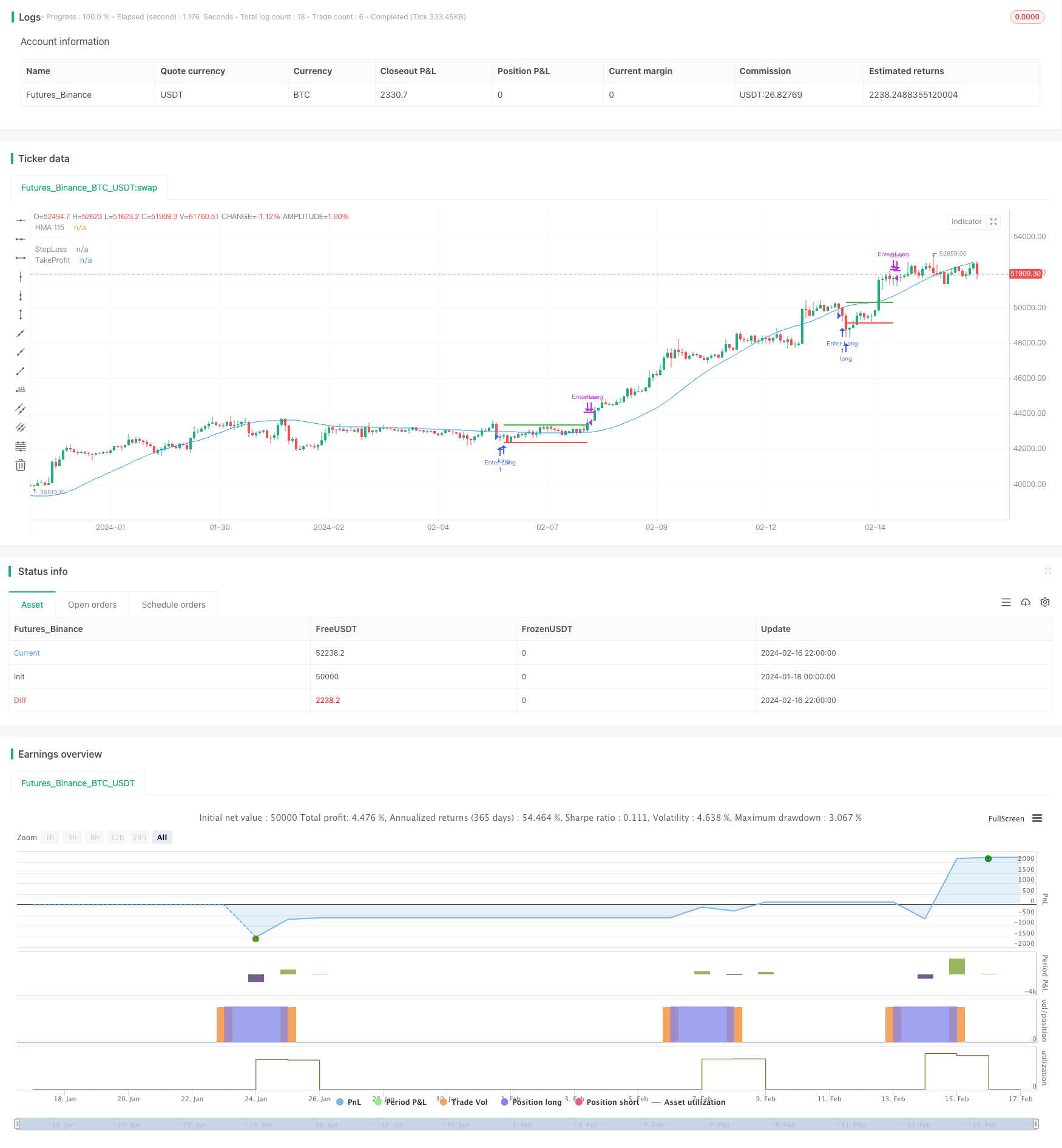
概述
本策略名称为“动态移动平均线突破入场、固定止盈止损出场的量化交易策略”。该策略的主要思想是在每周一当日的交易时段,如果收盘价低于115周期的 Hull 动态移动平均线,那么进行长仓入场操作;在其后的每周三当日的交易时段,无条件进行平仓出场操作,同时设置固定的止盈止损点。
策略原理
该策略主要基于Hull移动平均线的指标信号和周期性的交易规则进行设计。
首先,在每周一的交易时段,判断收盘价是否低于115周期的Hull移动平均线,如果满足条件,进行长仓入场操作。Hull移动平均线相比普通移动平均线,能更快地响应价格变化,对趋势的识别更加敏感,因此该指标信号可以提高入场时机的准确性。
其次,无条件地在每周三的交易时段进行平仓出场。通过这种周期性的操作方式,可以避免被突发事件影响,降低回撤的概率。同时设置了固定比例的止盈止损点,以控制每次交易的风险和收益。
最后,由于每次交易持仓的时间跨度较短,交易频次较高,这可以在一定程度上调整仓位,降低单笔交易的风险。
优势分析
本策略具有以下几个优势:
使用Hull移动平均线作为入场信号指标,可以提高入场时机选择的准确性,捕捉趋势机会。
采用周期性的出场方式,可以规避非理性行为带来的风险,降低回撤概率。
设置固定的止盈止损点,可以很好控制单笔交易的风险收益比。
交易频次较高,有利于调整仓位,降低单笔交易的风险。
策略规则简单清晰,容易理解与实现,适合量化交易的算法化。
风险分析
本策略也存在一些风险,主要包括:
市场可能出现长时间盘整,导致入场后被套牢的概率较大。
固定的止盈止损点设置不够灵活,可能出现止损过早或止盈过晚的情况。
若出现重大且突发的行情事件,周期性的出场方式可能带来较大的亏损。
频繁交易会增加交易成本和滑点的影响。
参数设置(如计算周期长度等)不当可能影响策略表现。
为了降低上述风险,可以考虑以下几点优化措施:
在入场前判断市场格局,避免在盘整时入场。
设置动态滑动止盈止损或考虑事先设定多个固定止盈止损点。
在重大事件前后暂停交易,避开行情剧烈波动的时段。
适当减少交易频次,降低交易成本和滑点的影响。
优化参数设置,进行稳健性检验,使策略更加稳定。
优化方向
本策略还有进一步优化的空间,主要包括以下几个方面:
使用机器学习等方法动态优化移动平均线的参数,使指标信号更加准确。
尝试结合多个指标进行组合,设计更加复杂的入场和出场规则。
根据不同时间段和市场环境设计自适应的止盈止损机制。
融入风险管理模型,实现更好的资金管理。
设计断点复权模块,使策略能顺利完成股票拆股等重要事件。
添加实盘验证模块,检验策略在实盘中的表现。
通过机器学习、指标组合、自适应止盈止损、风险管理等方式的融合与优化,本策略可以获得更强的稳定性与收益性。同时加入实盘验证机制是进一步完善策略的重要手段。这些都是本策略未来可以优化的主要方向。
总结
本策略基于 Hull 动态移动平均线指标信号入场以及固定周期出场的思路进行设计,具有指标信号准确、回撤概率低等优势,同时控制了单笔交易的止盈止损。但本策略也存在被套、止盈止损设置不合理等问题。未来的优化方向包括引入机器学习和更复杂的多指标组合入场,设计自适应的止盈止损机制,加入断点复权和实盘验证模块等。通过这些措施的综合运用,本策略的稳定性和盈利能力都将得到提升。
/*backtest
start: 2024-01-18 00:00:00
end: 2024-02-17 00:00:00
period: 2h
basePeriod: 15m
exchanges: [{"eid":"Futures_Binance","currency":"BTC_USDT"}]
*/
// This Pine Script™ code is subject to the terms of the Mozilla Public License 2.0 at https://mozilla.org/MPL/2.0/
// © gnatskiller
//@version=5
strategy("Strategia HMA + LUN/MER", overlay=true)
// Inputs: stoploss %, takeProfit %
stopLossPercentage = input.float(defval=0.8, title='StopLoss %', minval=0.1, step=0.2) / 100
takeProfit = input.float(defval=1.5, title='Take Profit %', minval=0.3, step=0.2) / 100
// Calculate HMA 115
hma115 = ta.hma(close, 115)
// Exit and Entry Conditions - Check current day, session time, and price below HMA 115
isLong = dayofweek == dayofweek.monday and not na(time(timeframe.period, "1000-1101")) and close < hma115
isExit = dayofweek == dayofweek.wednesday and not na(time(timeframe.period, "1000-1101"))
// Calculate Stoploss and Take Profit values
SL = strategy.position_avg_price * (1 - stopLossPercentage)
TP = strategy.position_avg_price * (1 + takeProfit)
// Strategy Enter, and exit when conditions are met
if isLong
strategy.entry("Enter Long", strategy.long)
if strategy.position_size > 0
if isExit
strategy.close("Enter Long", comment="Exit")
strategy.exit("Exit", "Exit", stop=SL, limit=TP)
// Plot Stoploss and TakeProfit lines
plot(strategy.position_size > 0 ? SL : na, style=plot.style_linebr, color=color.red, linewidth=2, title="StopLoss")
plot(strategy.position_size > 0 ? TP : na, style=plot.style_linebr, color=color.green, linewidth=2, title="TakeProfit")
// Plot HMA 115
plot(hma115, color=color.blue, title="HMA 115")